Migrants raise hands to catch bottles of water thrown by volunteers of humanitarian organisations as they wait to cross the Greek-Macedonian border near the village of Idomeni, northern Greece: photo by Sakis Mitrolidis/AFP, 4 September 2015
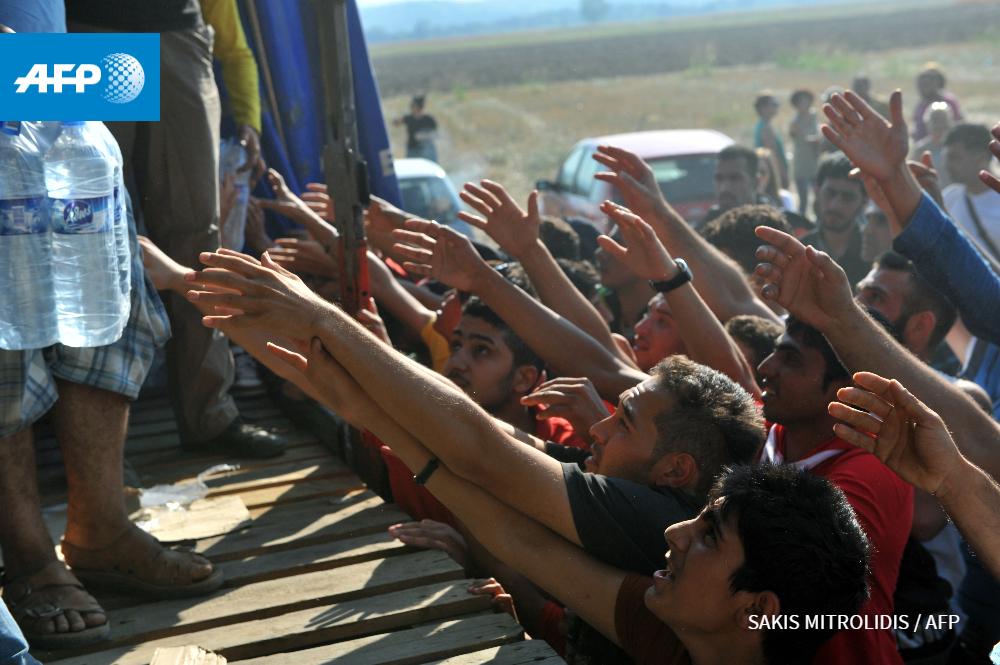
#migrants raise their hands to catch bottles of water near Idomeni. #AFP Photo @SakisMitrolidis: image via AFP Photo Department @AFPphoto, 5 September 2015

#migrants raise their hands to catch bottles of water near Idomeni. #AFP Photo @SakisMitrolidis: image via AFP Photo Department @AFPphoto, 5 September 2015
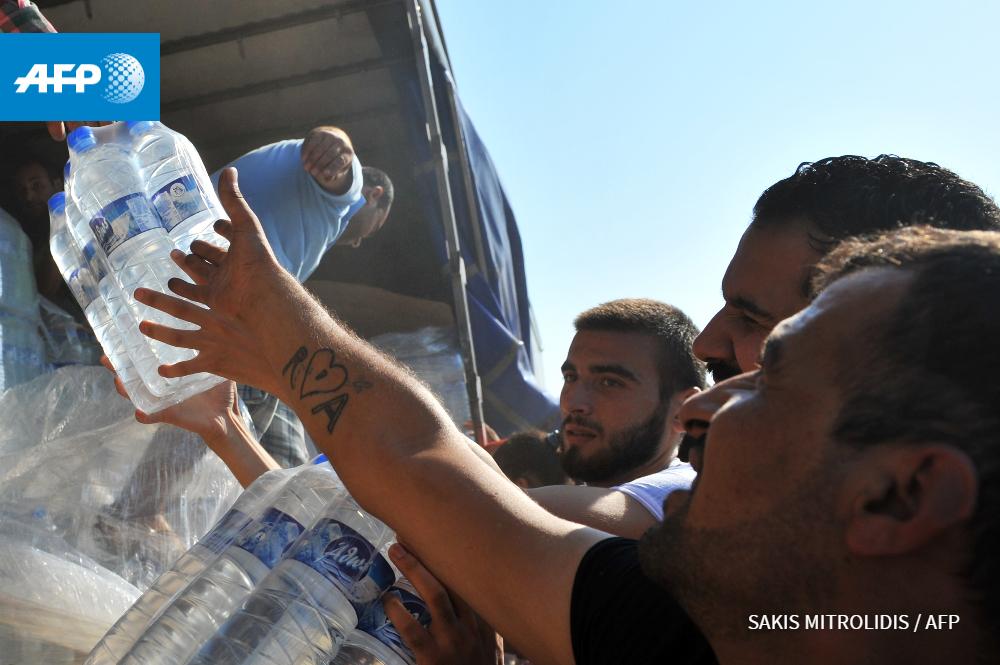
#migrants raise their hands to catch bottles of water near Idomeni. #AFP Photo @SakisMitrolidis: image via AFP Photo Department @AFPphoto, 5 September 2015
Migrants raise hands to catch bottles of water thrown by volunteers of humanitarian organisations as they wait to cross the Greek-Macedonian border near the village of Idomeni, northern Greece: photo by Sakis Mitrolidis/AFP, 4 September 2015
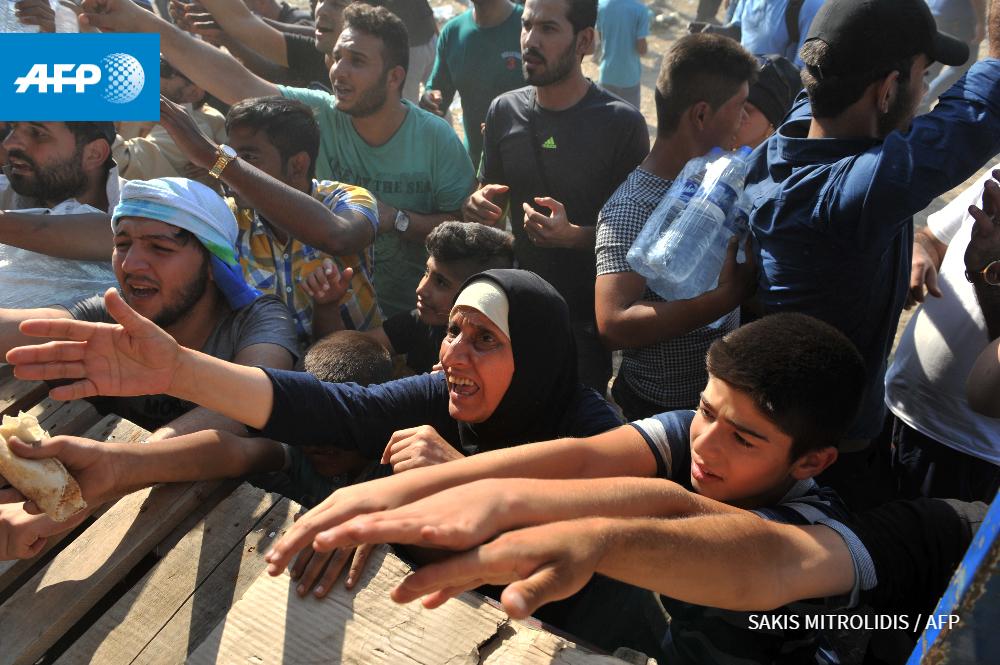
#migrants raise their hands to catch bottles of water near Idomeni. #AFP Photo @SakisMitrolidis: image via AFP Photo Department @AFPphoto, 5 September 2015
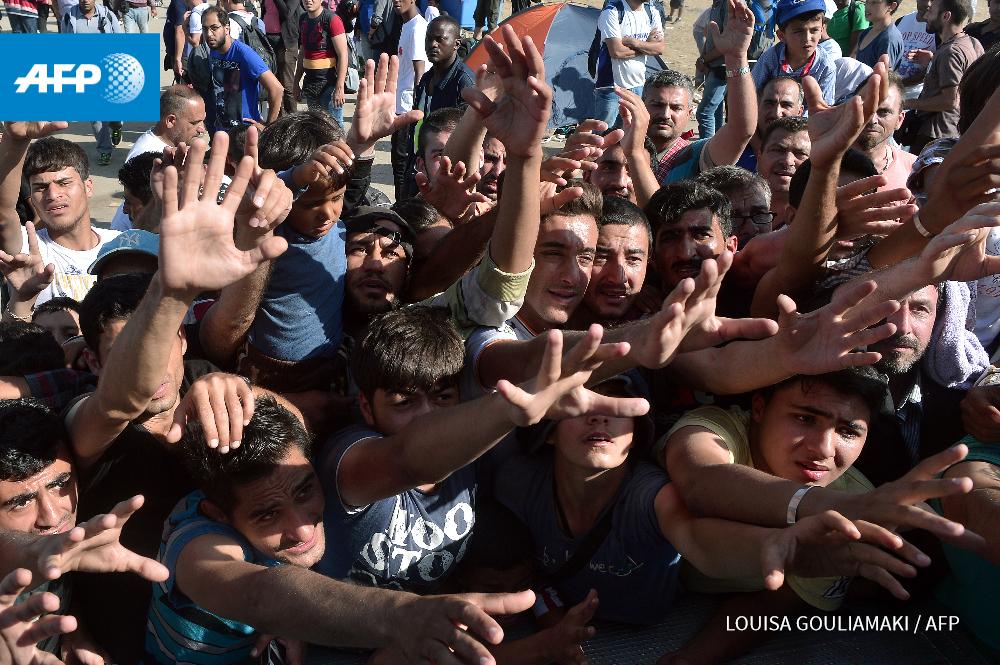
Migrants reach out for food and water distributed on Greek-FYR Macedonia border near Idomeni #AFP Photo by @lgouliam: image via Uta Tochtermann @utatoc, 5 September 2015
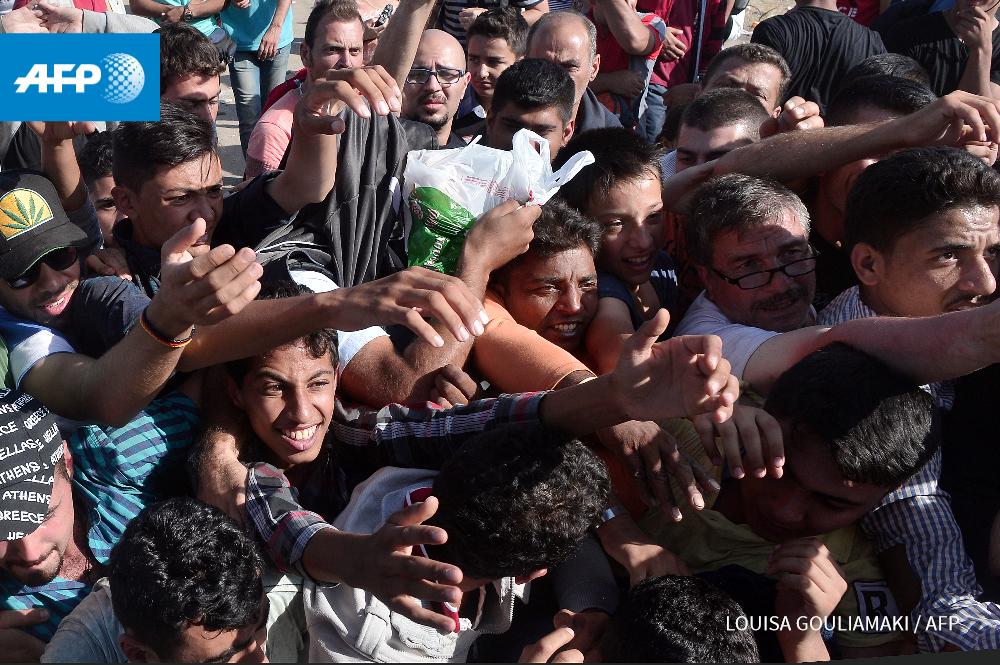
Migrants reach out for food and water distributed on Greek-FYR Macedonia border near Idomeni #AFP Photo by @lgouliam: image via Uta Tochtermann @utatoc, 5 September 2015
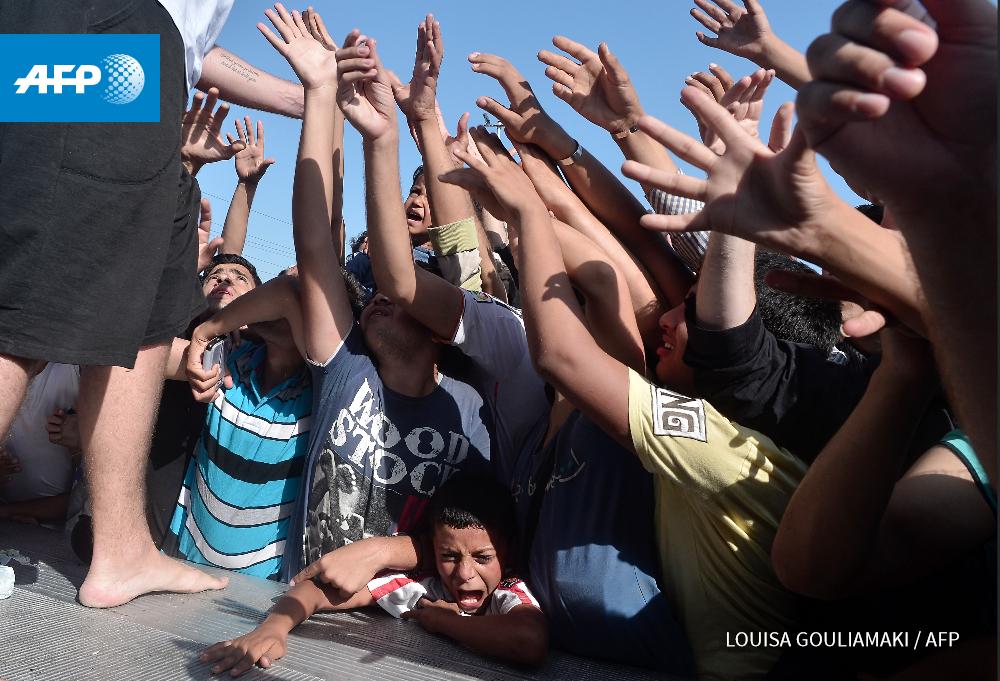
Migrants reach out for food and water distributed on Greek-FYR Macedonia border near Idomeni #AFP Photo by @lgouliam: image via Uta Tochtermann @utatoc, 5 September 2015
Migrants raise hands to catch bottles of water thrown by volunteers of humanitarian organisations as they wait to cross the Greek-Macedonian border near the village of Idomeni, northern Greece: photo by Sakis Mitrolidis/AFP, 4 September 2015
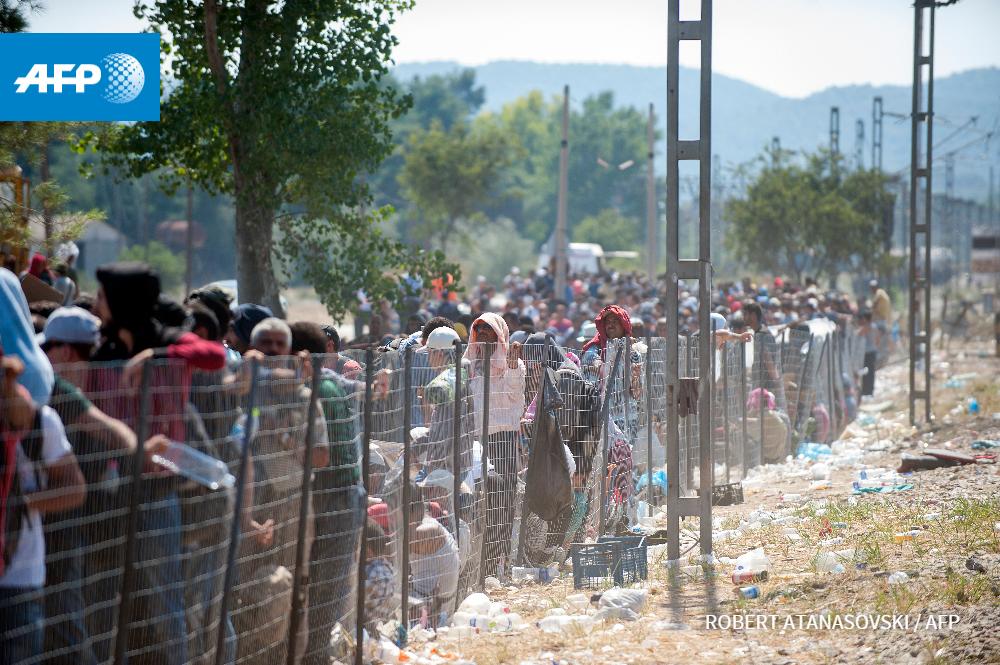
#migrantcrisis Border between Greece and Macedonia near Gevgelija today. #AFP @RAtanasovski image via Aurelia BAILLY @Aurelia BAILLY, 3 September 2015
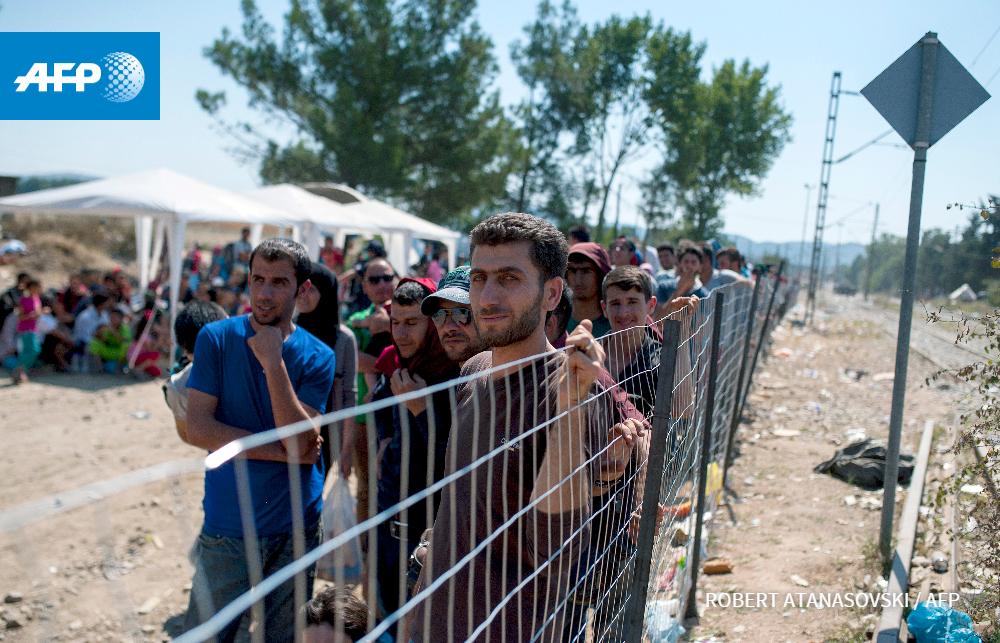
#migrantcrisis Border between Greece and Macedonia near Gevgelija today. #AFP @RAtanasovski: image via Aurelia BAILLY @Aurelia BAILLY, 3 September 2015
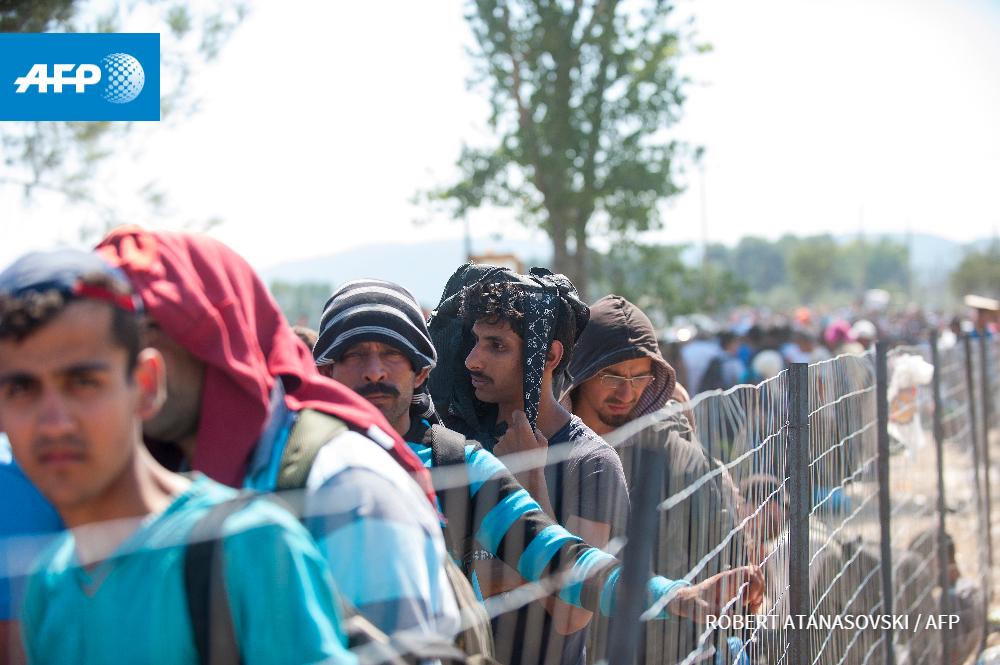
#migrantcrisis Border between Greece and Macedonia near Gevgelija today. #AFP @RAtanasovski: image via Aurelia BAILLY @Aurelia BAILLY, 3 September 2015
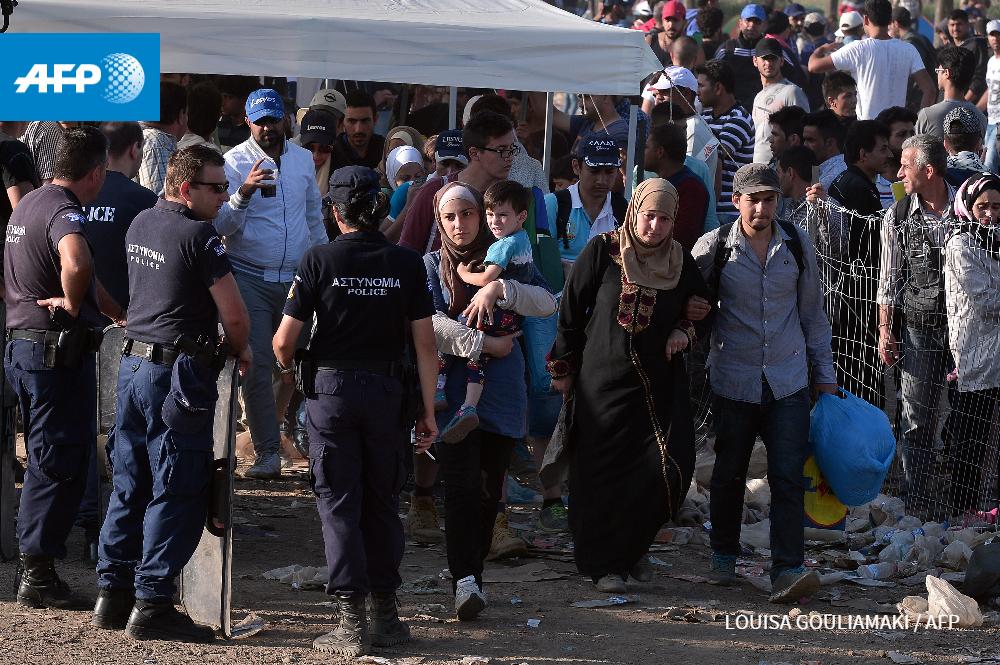
#migrants at the Greek-FYR Macedonian borders near Idomeni on September 5. #AFP Photo by @lgouliam: image via Aurelia BAILLY @Aurelia BAILLY, 5 September 2015

#migrants at the Greek-FYR Macedonian borders near Idomeni on September 5. #AFP Photo by @lgouliam: image via Aurelia BAILLY @Aurelia BAILLY, 5 September 2015
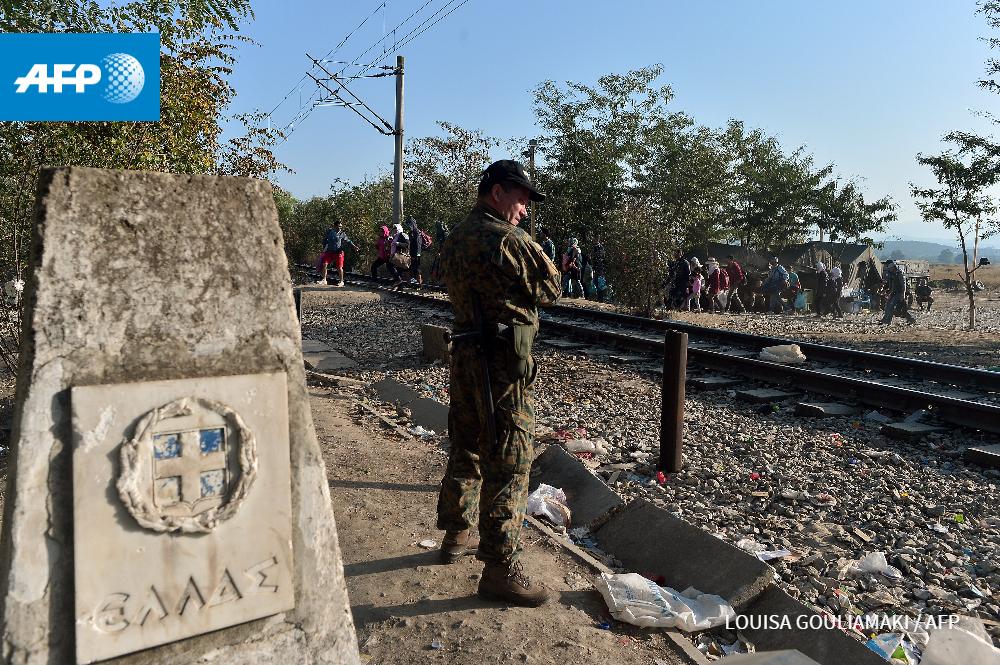
#migrants at the Greek-FYR Macedonian borders near Idomeni on September 5. #AFP Photo by @lgouliam: image via Aurelia BAILLY @Aurelia BAILLY, 5 September 2015
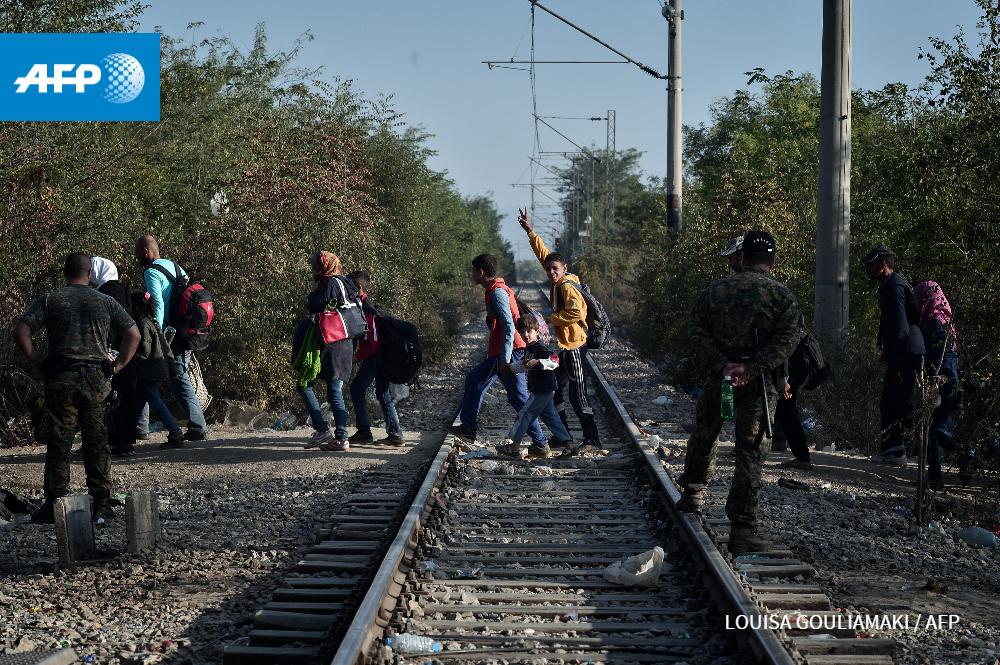
#migrants at the Greek-FYR Macedonian borders near Idomeni on September 5. #AFP Photo by @lgouliam: image via Aurelia BAILLY @Aurelia BAILLY, 5 September 2015

#migrants on their way to cross the Greek-Macedonian border near Idomeni. #AFP Photo @SakisMitrolidis: image via Aurelia BAILLY @Aurelia BAILLY, 4 September 2015
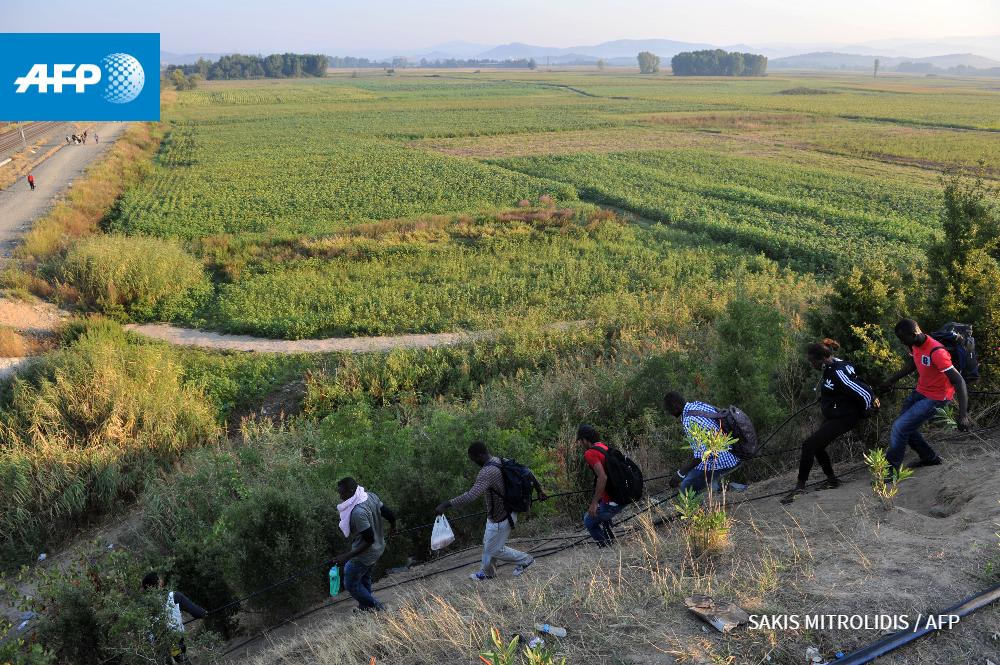
#migrants on their way to cross the Greek-Macedonian border near Idomeni. #AFP Photo @SakisMitrolidis: image via Aurelia BAILLY @Aurelia BAILLY, 4 September 2015
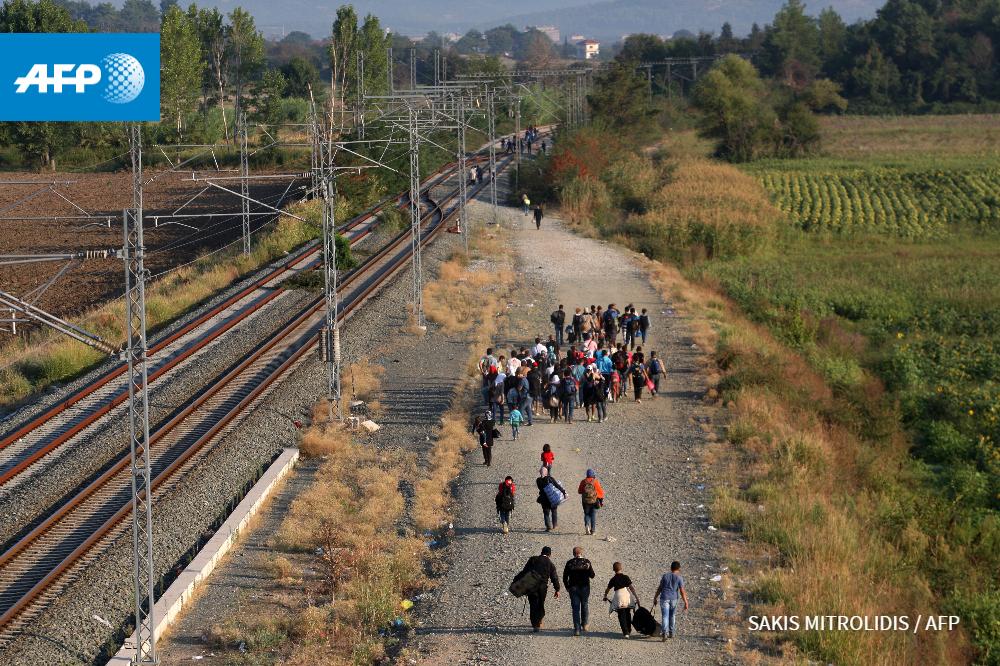
#migrants on their way to cross the Greek-Macedonian border near Idomeni. #AFP Photo @SakisMitrolidis: image via Aurelia BAILLY @Aurelia BAILLY, 4 September 2015
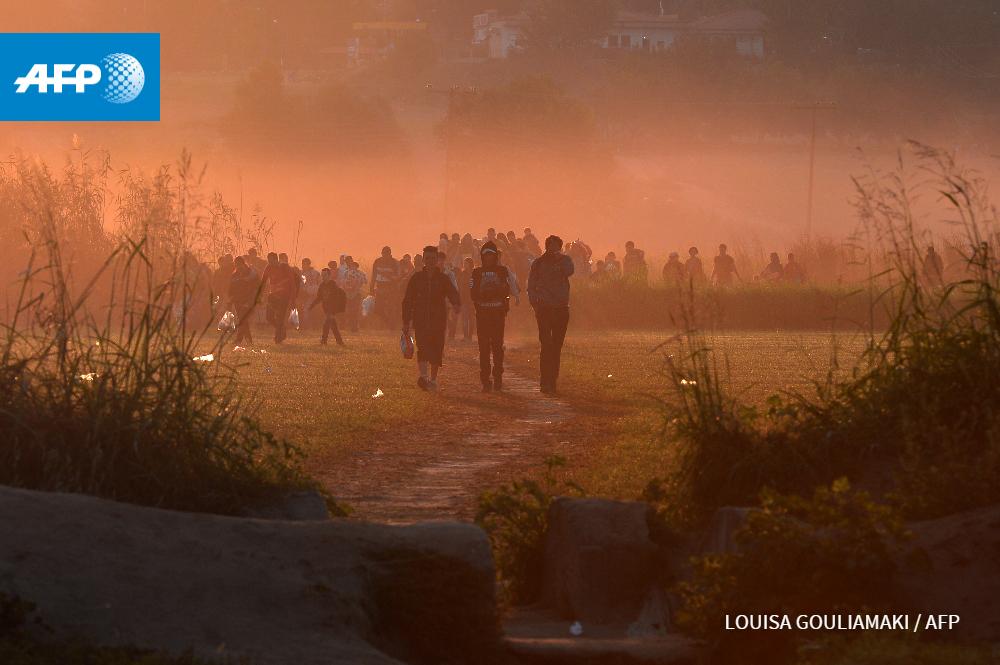
#migrants make their way towards the Greek-FYR Macedonian borders. #AFP Photo by @lgouliam: image via Aurelia BAILLY @Aurelia BAILLY, 5 September 2015
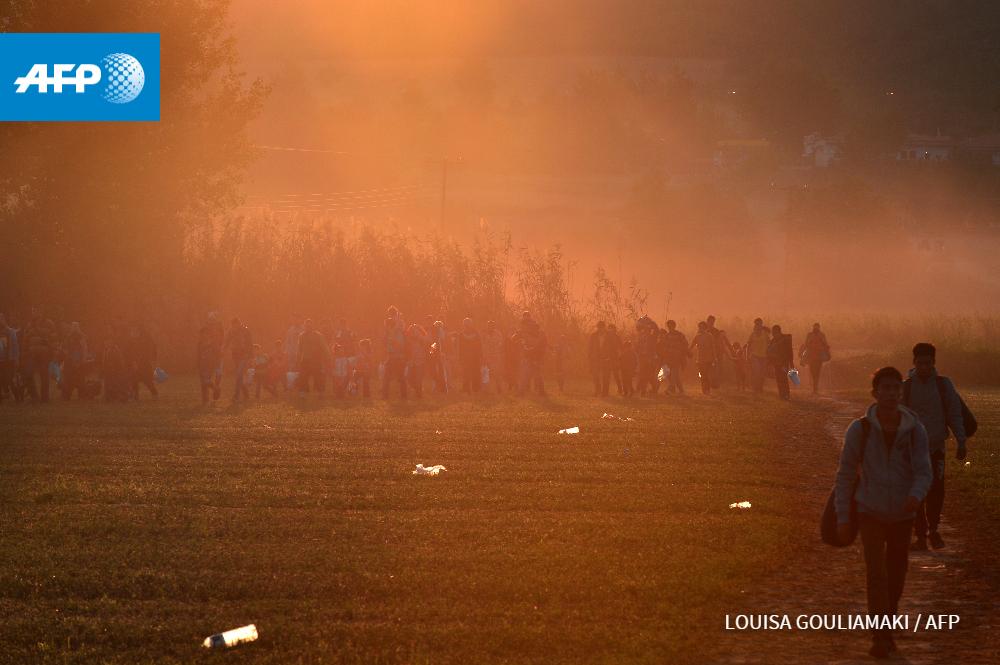
#migrants make their way towards the Greek-FYR Macedonian borders. #AFP Photo by @lgouliam: image via Aurelia BAILLY @Aurelia BAILLY, 5 September 2015
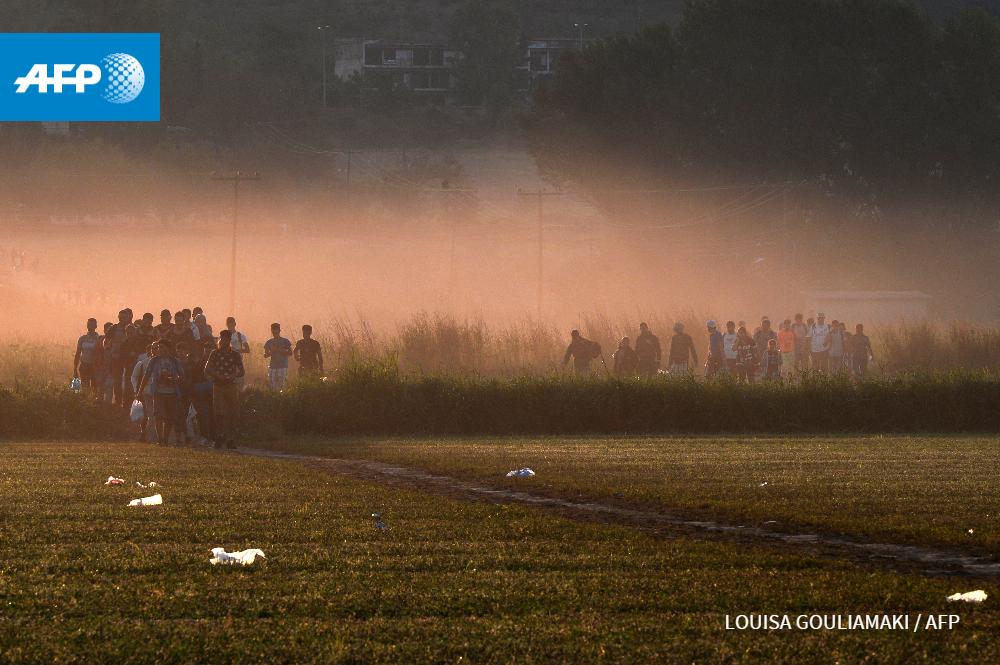
#migrants make their way towards the Greek-FYR Macedonian borders. #AFP Photo by @lgouliam: image via Aurelia BAILLY @Aurelia BAILLY, 5 September 2015
William Blake: Europe a Prophecy, 1794

Europe a Prophecy:
William Blake, 1794, relief and white-line etching with color printing
and hand coloring, object 1, 23 x 16.9 cm (Glasgow University Library)

Europe a Prophecy: William Blake, 1794, relief and white-line etching with color printing and hand coloring, object 2, 23.9 x 17.3 cm

Europe a Prophecy: William Blake, 1794, relief and white-line etching with color printing and hand coloring, object 3, 23.6 x 17.1 cm (Glasgow University Library)

Europe a Prophecy: William Blake, 1794, relief and white-line etching with color printing and hand coloring, object 4, 23.6 x 17.3 cm (Glasgow University Library)

Europe a Prophecy: William Blake, 1794, relief and white-line etching with color printing and hand coloring, object 5, 23.6 x 15.7 cm (Glasgow University Library)

Europe a Prophecy: William Blake, 1794, relief and white-line etching with color printing and hand coloring, object 6, 23.1 x 16.4 cm (Glasgow University Library)

Europe a Prophecy: William Blake, 1794, relief and white-line etching with color printing and hand coloring, object 7, 23.6 x 17.2 cm (Glasgow University Library)

Europe a Prophecy: William Blake, 1794, relief and white-line etching with color printing and hand coloring, object 8, 23.7 x 17.1 cm (Glasgow University Library)

Europe a Prophecy: William Blake, 1794, relief and white-line etching with color printing and hand coloring, object 9, 23.6 x 16.7 cm (Glasgow University Library)

Europe a Prophecy: William Blake, 1794, relief and white-line etching with color printing and hand coloring, object 10, 23.4 x 16.6 cm (Glasgow University Library)

Europe a Prophecy: William Blake, 1794, relief and white-line etching with color printing and hand coloring, object 11, 23.4 x 16.7 cm (Glasgow University Library)

Europe a Prophecy: William Blake, 1794, relief and white-line etching with color printing and hand coloring, object 12, 23.4 x 16.9 cm (Glasgow University Library)

Europe a Prophecy: William Blake, 1794, relief and white-line etching with color printing and hand coloring, object 13, 23.4 x 17.0 cm (Glasgow University Library)

Europe a Prophecy: William Blake, 1794, relief and white-line etching with color printing and hand coloring, object 14, 23.4 x 17.3 cm (Glasgow University Library)

Europe a Prophecy: William Blake, 1794, relief and white-line etching with color printing and hand coloring, object 15, 23.3 x 16.9 cm (Glasgow University Library)

Europe a Prophecy: William Blake, 1794, relief and white-line etching with color printing and hand coloring, object 16, 23.3 x 16.5 cm (Glasgow University Library)

Europe a Prophecy: William Blake, 1794, relief and white-line etching with color printing and hand coloring, object 17, 23.4 x 16.6 cm (Glasgow University Library)
A Journey to the unknown
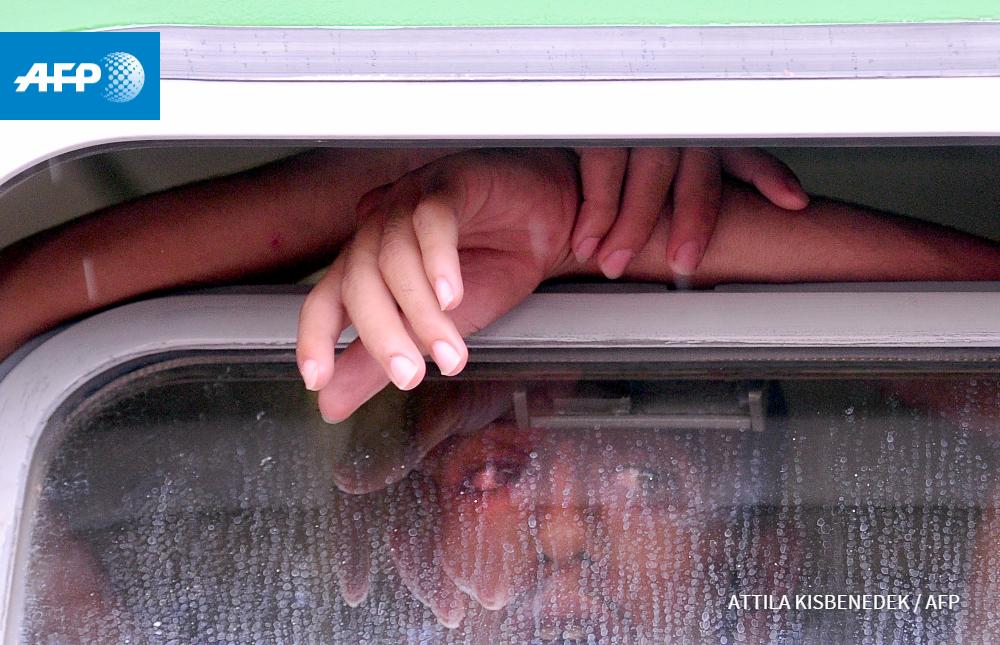
#migrantcrisis #Hungary Migrants on a train at a railway station in Budapest yesterday. #AFP @afpattila: image via Aurelia BAILLY @Aurelia BAILLY, 4 September 2015
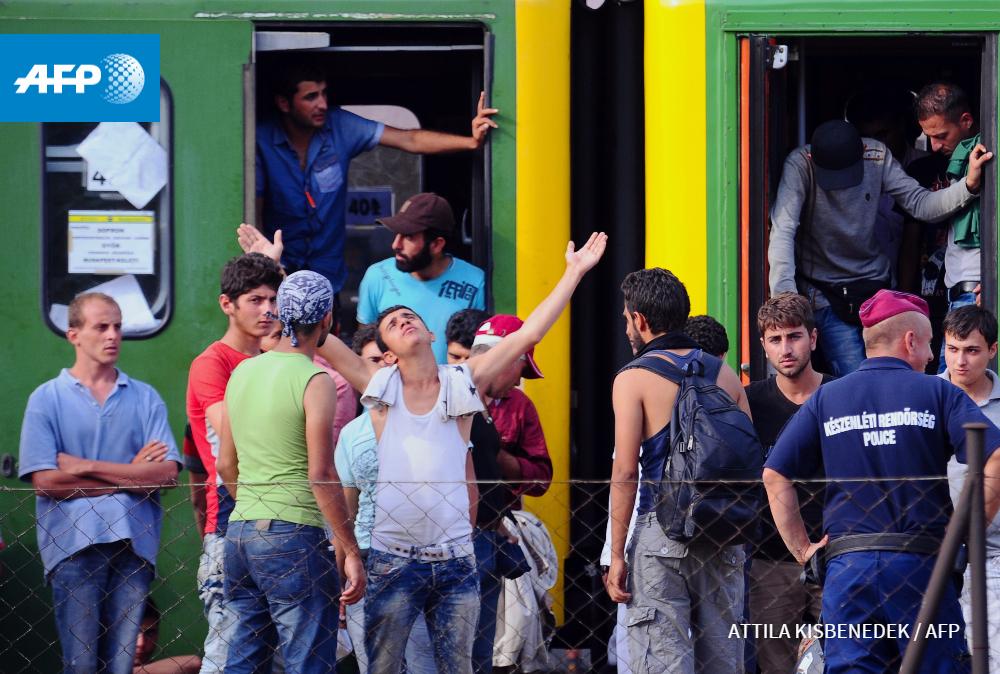
#migrantcrisis #Hungary Migrants on a train at a railway station in Budapest yesterday. #AFP @afpattila: image via Aurelia BAILLY @Aurelia BAILLY, 4 September 2015
A journey to the unknown on the Balkan migrant route, day 2: Ghost train through Macedonia #AFP: image via AFP Correspondent @AFPblogs, 3 September 2015
A journey to the unknown, day 3: Belgrade, refugees' respite ahead of looming Hungary #AFP: image via AFP Correspondent @AFPblogs, 4 September 2015
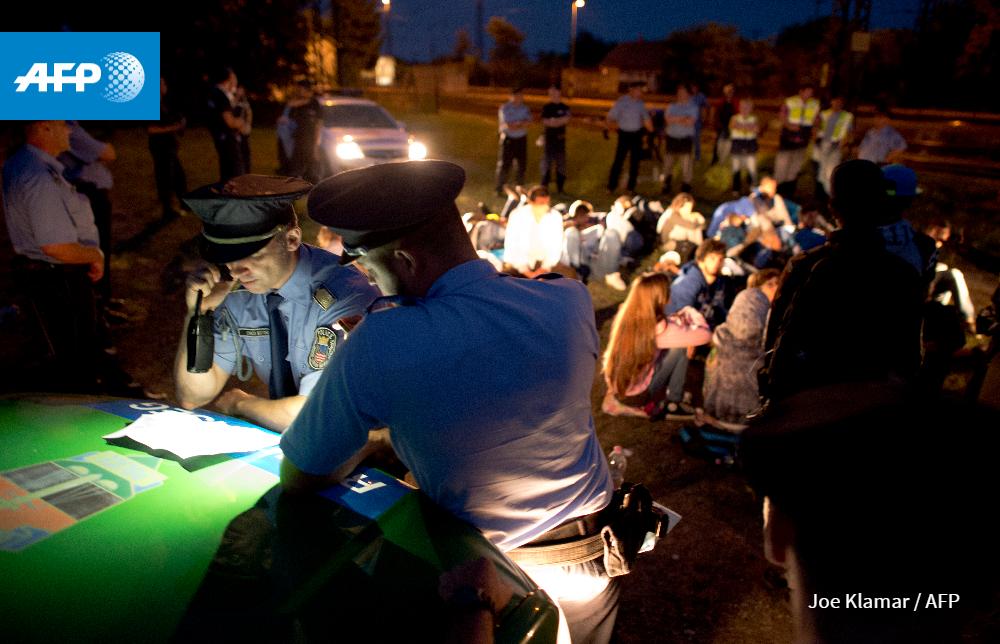
#Hungary #migrants held by police near the train station of Nagyszentjanos, yesterday. #AFP Photo by Joe Klamar: image via Aurelia BAILLY @Aurelia BAILLY, 4 September 2015
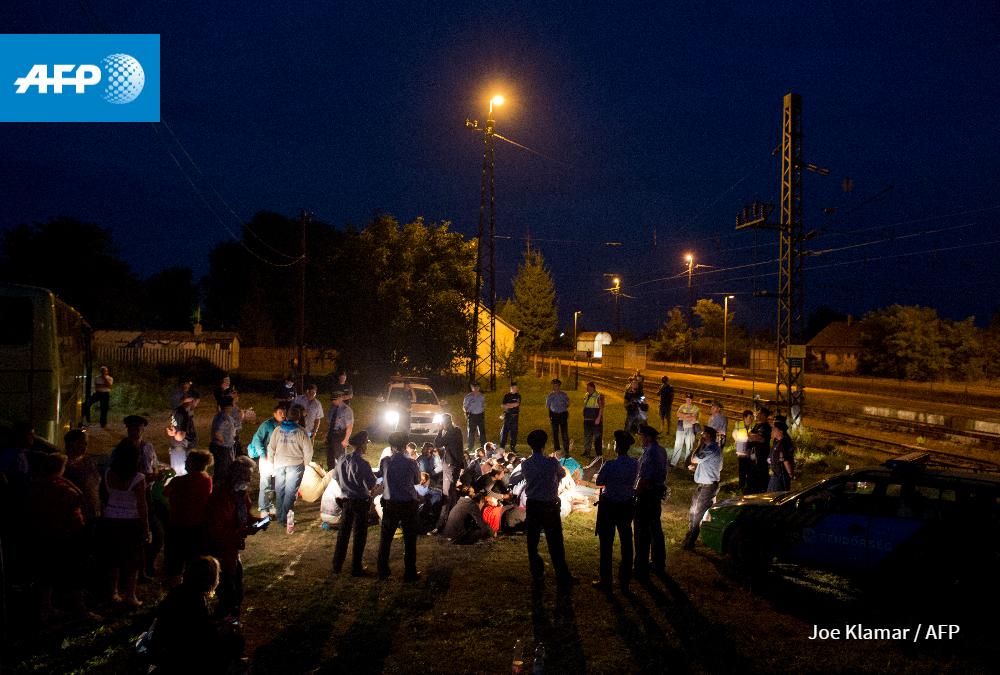
#Hungary #migrants held by police near the train station of Nagyszentjanos, yesterday. #AFP Photo by Joe Klamar: image via Aurelia BAILLY @Aurelia BAILLY, 4 September 2015
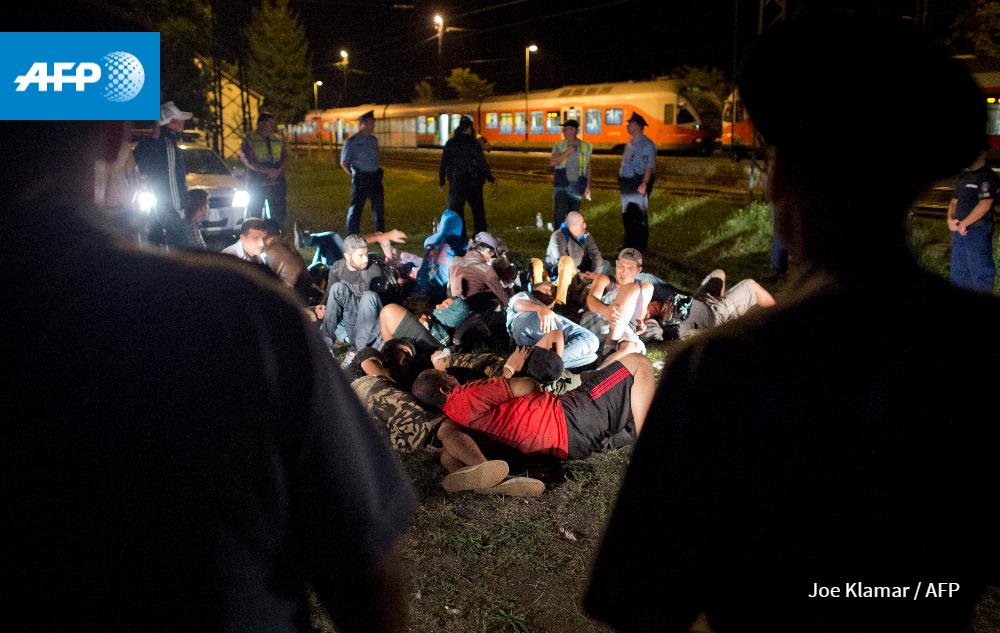
#Hungary #migrants held by police near the train station of Nagyszentjanos, yesterday. #AFP Photo by Joe Klamar: image via Aurelia BAILLY @Aurelia BAILLY, 4 September 2015

#Hungary #migrants held by police near the train station of Nagyszentjanos, yesterday. #AFP Photo by Joe Klamar: image via Aurelia BAILLY @Aurelia BAILLY, 4 September 2015
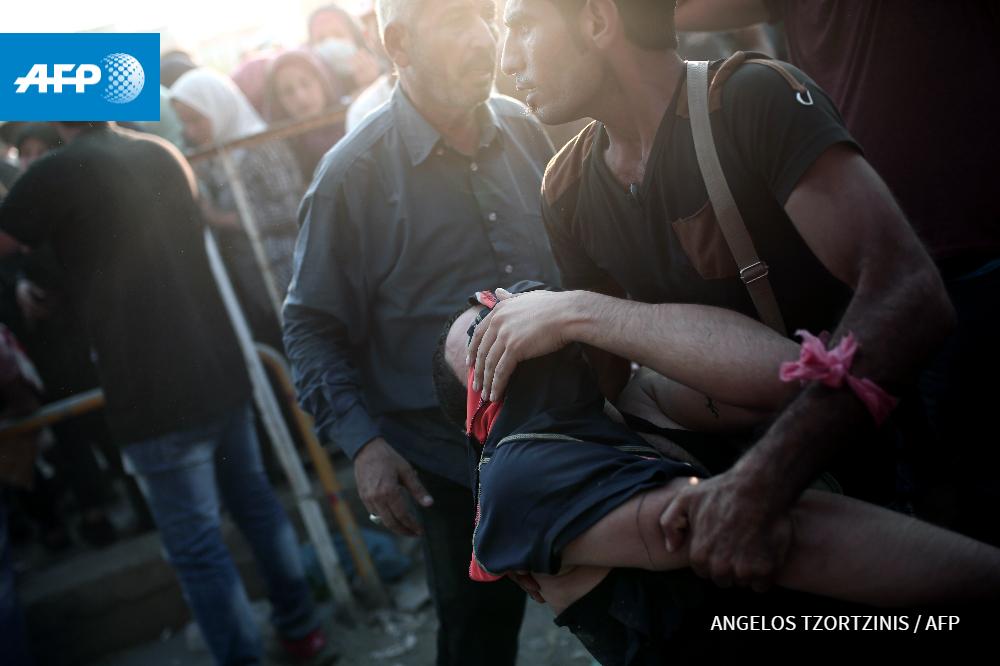
#migrantcrisis #Greece Refugees wait to be registered in the port of Mytilene, on Lesbos yesterday. #AFP @atzortzinis: image via Aurelia BAILLY @Aurelia BAILLY, 4 September 2015

#migrantcrisis #Greece Refugees wait to be registered in the port of Mytilene, on Lesbos yesterday. #AFP @atzortzinis: image via Aurelia BAILLY @Aurelia BAILLY, 4 September 2015
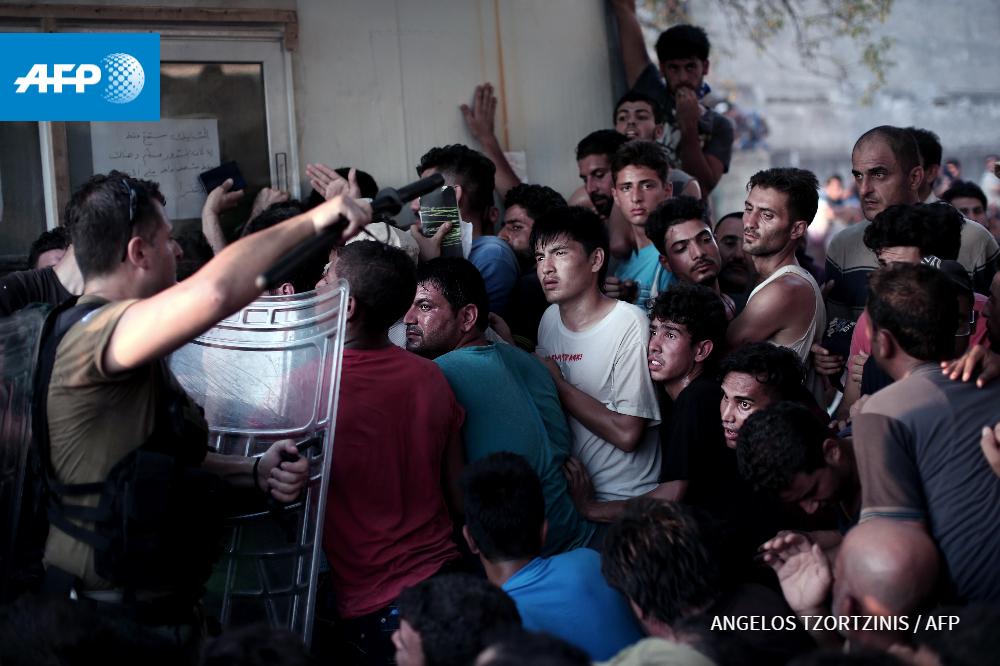
#migrantcrisis #Greece Refugees
wait to be registered in the port of Mytilene, on Lesbos yesterday. #AFP @atzortzinis: image via Aurelia BAILLY @Aurelia BAILLY, 4 September 2015
#migrantcrisis #Greece Refugees wait to be registered in the port of Mytilene, on Lesbos yesterday. #AFP @atzortzinis: image via Aurelia BAILLY @Aurelia BAILLY, 4 September 2015
A woman refugee collapses as she waits to be registered by police in Mytilene, on the Greek Aegean island of Lesbos: image via Anthony Wallace @AntAFP, 5 September 2015
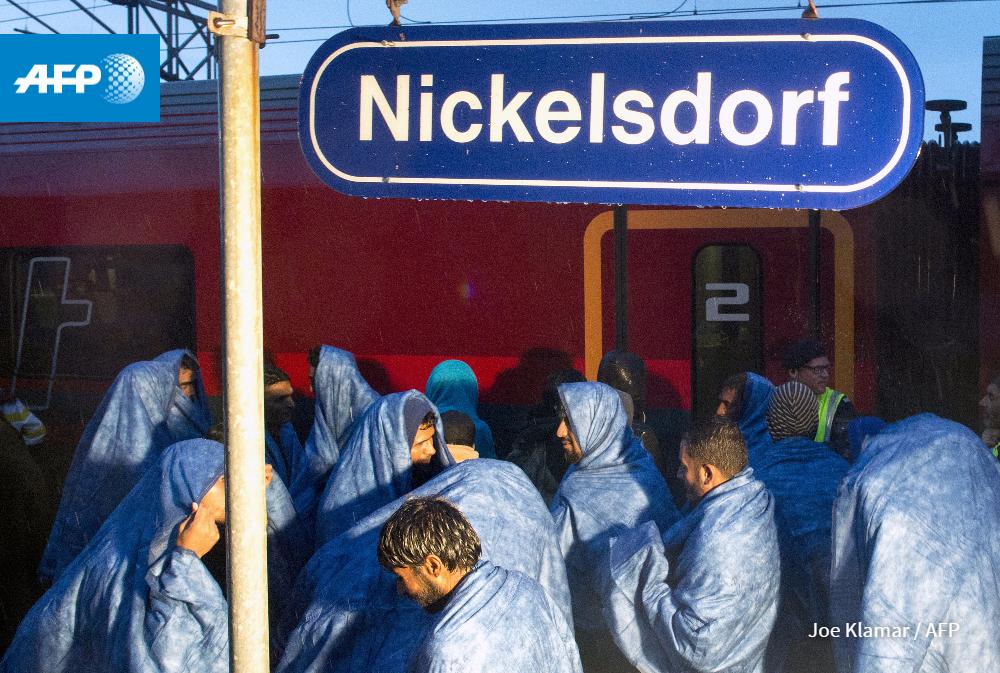
#migrants before boarding a train in the village of Nickelsdorf #Austria #AFP Photo by Joe Klamar: image via Aurelia BAILLY @Aurelia BAILLY, 5 September 2015
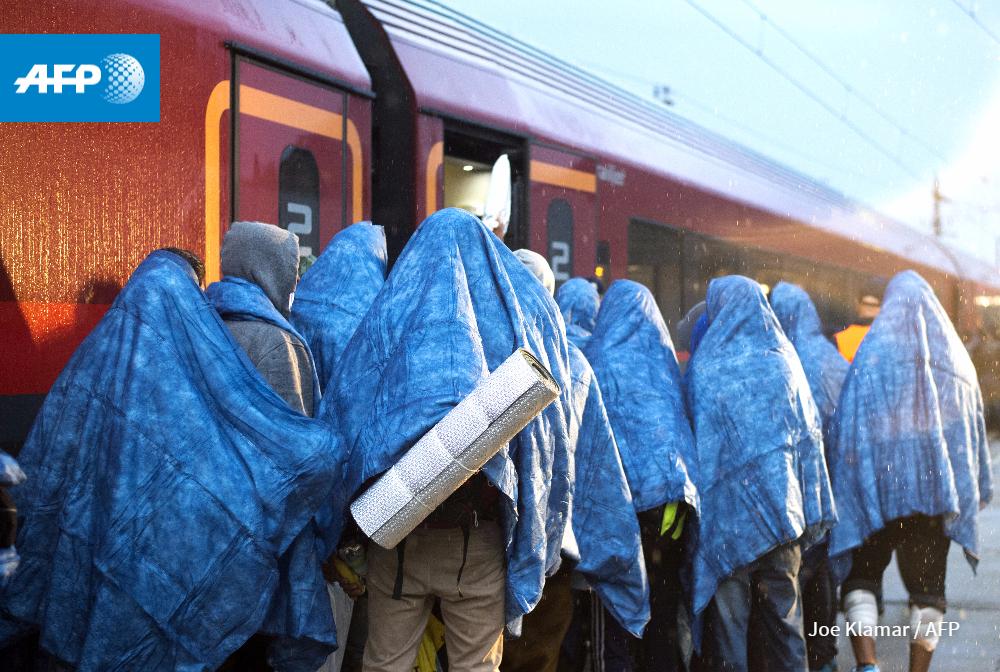
#migrants before boarding a train in the village of Nickelsdorf #Austria #AFP Photo by Joe Klamar: image via Aurelia BAILLY @Aurelia BAILLY, 5 September 2015
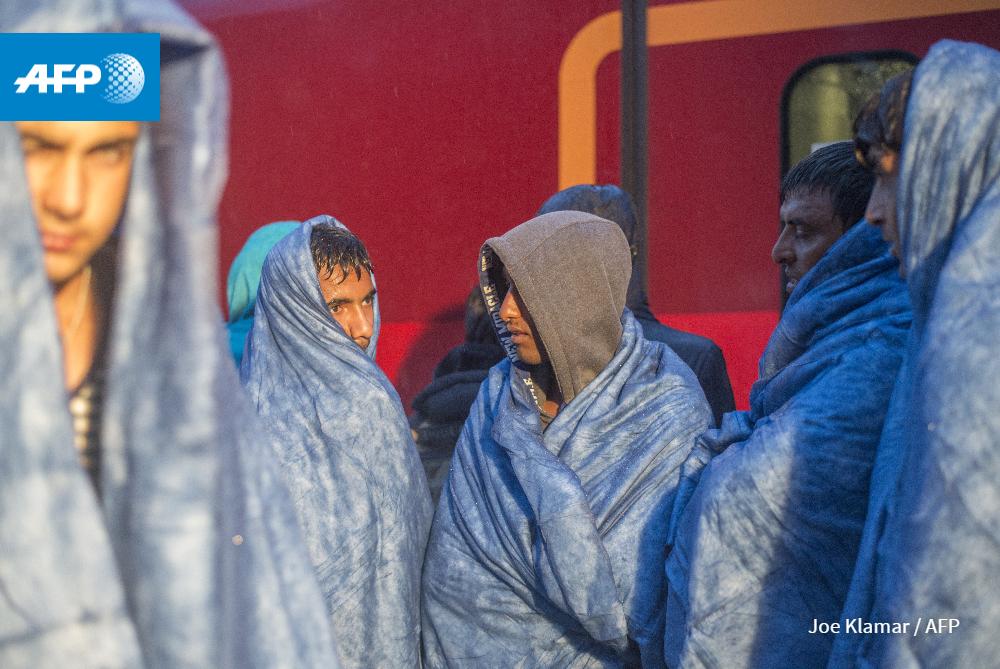
#migrants before boarding a train in the village of Nickelsdorf #Austria #AFP Photo by Joe Klamar: image via Aurelia BAILLY @Aurelia BAILLY, 5 September 2015
AUSTRIA - Migrants wait before boarding a train in Nickelsdorf in early hours to head to Salzburg. By Joe Klamar #AFP: image via Frédérique Geffard @fgeffardAFP, 5 September 2015
Refugees arrive in Austria after crossing the border from Hungary: image via The Telegraph @Telegraph, 5 September 2015
MACEDONIA - Children look out the window from a train heading to Serbia near Gevgelija. By @RAtanasovski #AFP: image via Frédérique Geffard @fgeffardAFP, 5 September 2015




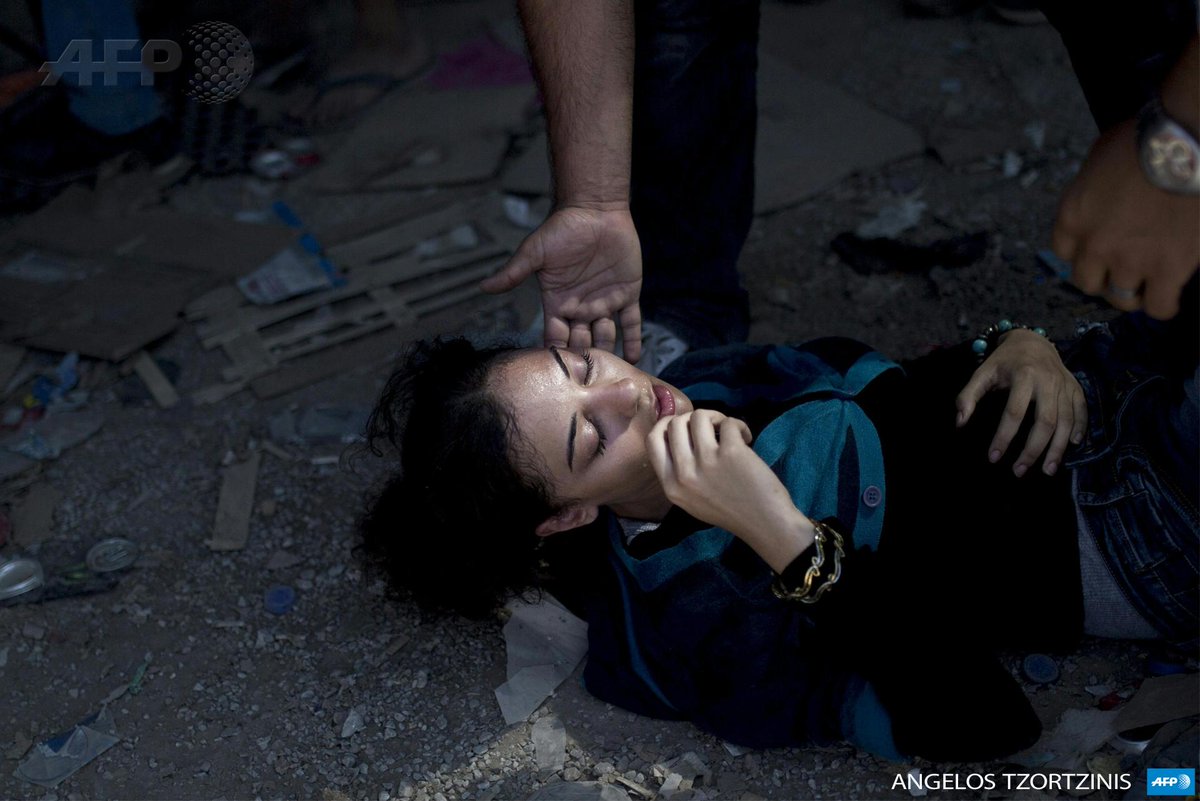


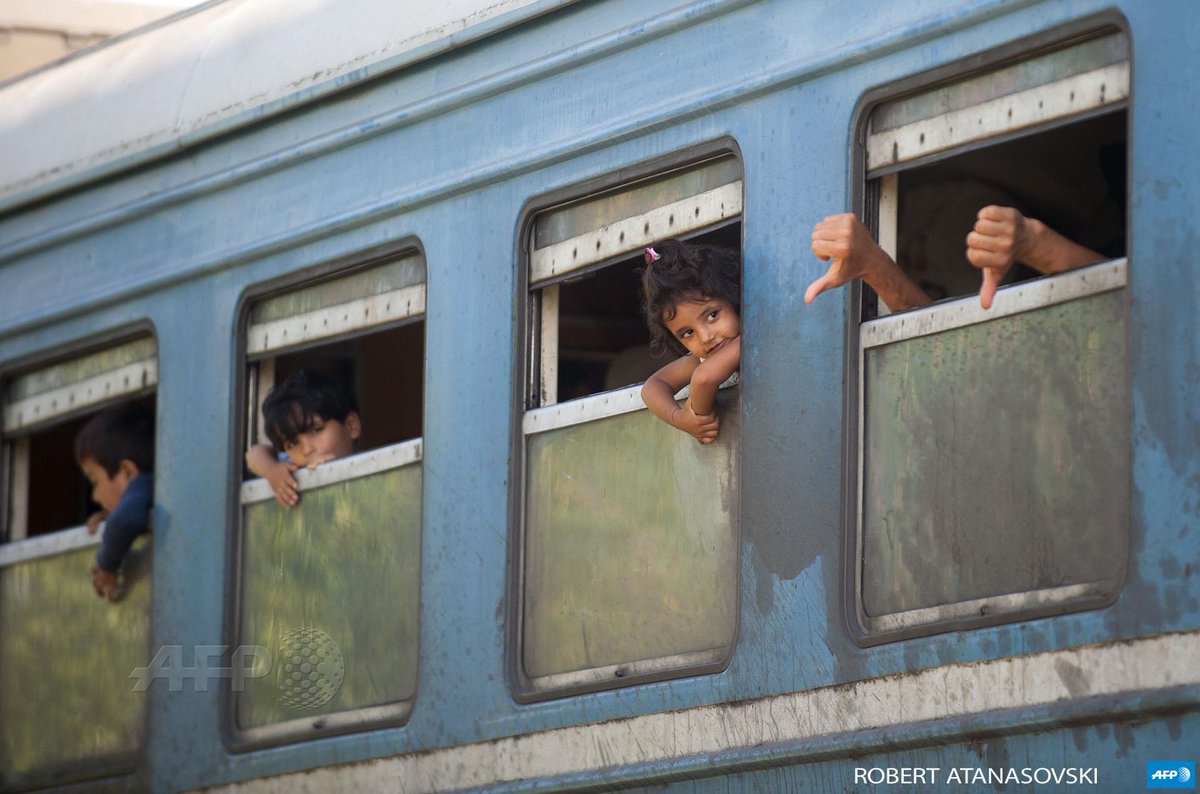
And Albion saith
ReplyDeleteI hear you knocking
etc.
Tom, well, somewhere amidst yesterday's swirling bewilderment, confused sorrow and premature jubilation (over the arrival in Germany of a few refugees, of course no more than a fraction of the exhausted wandering and floating masses, in their tens of thousands), I did notice that Sir Bob Geldof has offered to, if I've got this right, have them over for tea.
ReplyDeleteBut as no words have yet begun to encompass their suffering, nor ever will, I've found that the best (poor best, yet, from remote belated here, really the only) way to attempt to begin to understand is by way of the photos taken by the photographers from the countries through which the Exodus now passes.
As to the handiwork of the visionary poet of Lambeth aka Renascent Albion (dream on, Willy), a few notes from the Glasgow University Special Collections archivists might be relevant, or anyway of interest.
Viz.:
-
Frontispiece to Europe [object 1]. This work, often described (but not titled by Blake) as the "Ancient of Days", shows an old bearded man, Urizen, using a huge pair of compasses to delineate the material world at the moment of creation. This is a Gnostic interpretation of the creation story where a demiurge (a subordinate deity) rather than a benevolent God is the Creator.
Detail from the frontispiece showing the giant compasses marking out the material world. According to Anthony Blunt, this image is emblematic of much that Blake wishes to rail against in Europe. He sees this moment of creation as rational order being imposed on chaos - a moment of sublime error - the reduction of the infinite to the finite and therefore the destruction of imagination.
The first page of the preludium [object 3]. The image shows a bandit waiting to mug an unwitting traveller. While continuing the dualism of good and evil from the frontispiece and title page, the focus is shifted back to the human world. The image has also been read (by Erdman) as a political allegory adapted from one of Gillray's prints. The mugger in the cave represents Edmund Burke, an outspoken critic of Republican France, waiting to attack the"Everyman on his peaceful pilgrimage" (object 3).
Plate 6 [object 8]: this image is emblematic of the pain and misery suffered by mortals under Urizen's rule while Enitharmon sleeps. This image shows women weeping over a dead child.
Detail from plate 6: it has been suggested that the large cauldron will imminently be used to prepare an unthinkable meal! The idea of cannibalism as consequence of famine was not unusual in the late 18th Century.
Plate 7 [object 9]: a depiction of some unidentified danger approaching from off the page - this image is very powerful. The glow, reflected in the clouds in the background, has been identified (by Erdman) as the harbingers of war; while the couple represent all of the innocent victims of warfare.
Plate 11 [object 13]: This image depicts the Great plague of 1665 which, according to Dörrbecker, here symbolises all of the plagues suffered by mankind across the centuries. The shadow cast by the passing bell-man represents the shadow of death striking down the girl on the right of the plate.
Detail from plate 11: the girl who has been struck down by the plague reaches up heavenwards. This image is juxtaposed beside the inscription on the door "Lord have mercy on us", to show that the Lord's mercy has been denied these victims.
Detail from plate 14 [object 16] (mid-page): Baine suggests that this assortment of caterpillars, vultures, spiders and eagles are emblems of empire - all preying upon the helpless.
[Glasgow University Library Special Collections, continuing:]
ReplyDelete.
Europe: a Prophecy does not set out to be prophetic in the conventional sense: it does not set out to predict the future. Rather, according to Paley (in Dörrbecker), the function of the prophetic form is "to expose the otherwise hidden motives and consequences of human decisions". As Dörrbecker explains: "it is a 'prophetic' mode of historical representation as interpretation" where "the history of the immediate past is recounted as an exemplum with a view towards the future".
According to Piquet, Blake's Europe slides in comfortably beside a variety of apocalyptic poems written between 1790 and 1820 by several authors including Joan of Arc by Robert Southey, Destiny of Nations by Coleridge and Shelley's Queen Mab. Piquet suggests that all of these poems offer a transposition of Biblical books on a "different key". He suggests that they conform to a "millenarian" outlook where history is presented from a panoramic viewpoint. The poet/prophet uses flashbacks and anticipations of the future to simultaneously control the three dimensions of time: "a past brimming over with injustice and oppression, a present in which pent up energies break out, an imminent future marked by the advent of a Regained Paradise and the end of a woeful history of human suffering".
.
Europe comprises seventeen plates engraved, printed and coloured by Blake's own hand (an additional small preface plate has been found in two extant copies of the work - probably added after 1820). Blake was not a fan of ordinary typography, instead preferring that his major poems and epics should be read only in the illuminated printing style that he had designed. This process, which combines text and image, was apparently intended to mirror the appearance of medieval manuscripts. Europe, produced in 1794, was one of the earliest examples of this new technique.
The technique that Blake developed allowed him to have complete artistic control over his work: what Essick describes as "a unity between conception and execution". Blake largely used a technique known as relief etching to achieve the effects he desired. This process was easier and faster than traditional intaglio printing. Relief etching allowed the artist to paint the images and text (in reverse) directly onto the copper plate using an acid resistant varnish known as stopping-out solution. When placed in an acid bath, the uncovered areas of the plate were eaten away leaving the area "stopped out" standing in relief. The plates were subsequently inked with pigment specially thickened by mixing with carpenter's glue; this created a rich, heavy textured effect upon printing. The designs were usually tidied up later with watercolour and ink.
.
[Glasgow University Library Special Collections, concluding:]
ReplyDelete...[Blake's] illuminated books did not sell very well; their poor marketability combined with the high cost and time demands of creation resulted in very few of the books being produced. There are only twelve extant copies of Europe, of which three were printed posthumously. Of the nine remaining, two were printed in 1795 and another was produced late in Blake's life in 1821.
We can trace the provenance of our copy right back to the first half of the Nineteenth Century. The first known owner of the work is Thomas Griffiths Wainewright, a friend of Blake and a remarkable character. He was an accomplished poet and painter but also had a dark side. He was strongly suspected of murdering his sister-in-law, Helen Abercrombie, as part of an insurance scam although insufficient evidence was found to charge him. However, he was later arrested for forgery and transported to Tasmania where he died in 1847.
His copy of Europe was subsequently owned by Philip Augustus Hanrott who acquired the work from the book dealer H. G. Bohn, before selling it himself, to the book dealer French on 19th July 1833. Following a period of ownership by C. J. Toovey, Europe passed into the hands of the Cunliffe family where it remained until 1971. During the early period of its life, the copy was bound with two other Blake works, copy B of America: a Prophecy and Jerusalem, copy G. However, in 1963 Lord Cunliffe had the three works dis-bound. In 1971, Europe passed into the hands of H. M. Treasury in lieu of death duties. It was deposited in Glasgow University Library by the Treasury before finally being donated four years later in 1975.
__
[NB. There are, by the way, several other surviving copies of the Blake work, which may be found, along with this one I've used, at the William Blake Archive.]